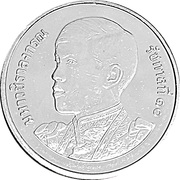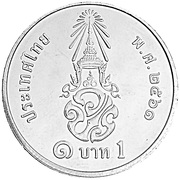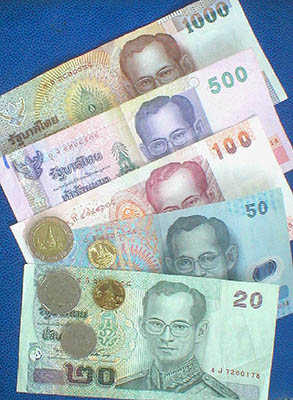
The baht is the official currency of Thailand. It can be divided into 100 satang. In which, the baht is formerly divided into 8 feuang and 64 att .The issuance of currency is the responsibility of the Bank of Thailand. SWIFT ranked the Thai baht as the 10th-most-frequently used world payment currency as of December 2023.

Bhumibol Adulyadej, conferred with the title King Bhumibol the Great, was the ninth king of Thailand from the Chakri dynasty, titled Rama IX, from 1946 until his death in 2016. His reign of 70 years and 126 days is the longest of any Thai monarch, the longest of an independent Asian sovereign and the third longest verified reign of any monarch of a sovereign state in history after Louis XIV and Elizabeth II.

Princess Sirindhorn of Thailand, the Princess Royal and the Princess Debaratana Rajasuda , formerly Princess Sirindhorn Debaratanasuda Kitivadhanadulsobhak, is the second daughter of King Bhumibol Adulyadej and younger sister of King Vajiralongkorn. Thais commonly refer to her as "Phra Thep", meaning "princess angel". Her title in Thai is the female equivalent of the title once held by her brother, King Maha Vajiralongkorn. The Thai constitution was altered in 1974 to allow for female succession, thus making her eligible for the throne. Having been the eldest female child of the royal family, her position is comparable to a princess royal.
The precedence of Thai royalty follows a system of ranks known as thanandon, which are accompanied by royal titles.

Wat Pavaranivesh Vihara Ratchawarawihan is a major Buddhist temple (wat) in Phra Nakhon district, Bangkok, Thailand. Being the residence of Nyanasamvara Suvaddhana; the late Supreme Patriarch of Thailand, it is the final resting place of two former kings of Chakri Dynasty; King Vajiravudh and King Bhumibol Adulyadej. The temple was established in 1824 by Mahasakti Pol Sep, viceroy during the reign of King Rama III.
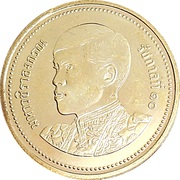
In Thailand, the two-baht coin is the coin which is worth 2 baht or 200 satang. The new 2-baht coin design features H.M. King Bhumibol Adulyadej, the Great on the obverse, like all other Thai legal tender coins presently in circulation. The reverse design depicts the Golden Mountain at Wat Saket Ratcha Wora Maha Wihan in Bangkok.

The Thailand five-baht coin is a denomination coin of the Thai baht, the Thai currency unit.
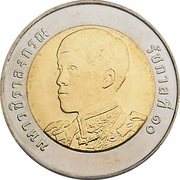
The bi-metallic Thailand ten-baht coin is a denomination coin of the Thai baht, the currency unit of Thailand.

Wat Chetawan is a Thai temple in Petaling District, Selangor, Malaysia. The temple is situated at Jalan Pantai, off Jalan Gasing in Petaling Jaya. It was built in 1957 and officiated by the late King Bhumibol Adulyadej, the King of Thailand at the time. The temple is also the only Malaysian Siamese temple which has been chosen as the custodian of the Buddha sacred relics for all Malaysian Buddhists that are parts of the ancient relics discovered in Piprahwa, a village in Uttar Pradesh near the border of the Kingdom of Nepal in 1898 which were presented to King Chulalongkorn of Siam by the then British Viceroy of India, Lord Curzon.
State decorations awarded by Thai King take the form of orders and medals. This page lists them by order of precedence.

Princess Bandhavanna Varobhas or Phra Chao Boromwongse Ther Phra Ong Chao Bandhavanna Varobhas, was a Princess of Siam. She was a member of the Siamese royal family. She was a daughter of Chulalongkorn, King Rama V of Siam.
The history of Thai money used as a medium of exchange and to settle accounts before the adoption of Thai baht coins and banknotes include novel designs and forms. For Thai people, money was considered as the symbol of civilization. Currency itself reflected faith in religion, culture, the customs and traditions of each era and also serve as a record of the development of Thailand.
The Pavilion of Regalia, Royal Decorations and Coins is a museum showcasing regalia, royal Thai decorations of the early period, historical Thai money and ornaments used in the royal courts. It is under the supervision of the Bureau of Grand National Treasure, the Treasury Department which has the responsibility to safeguard, conserve, and display national treasures.

King Bhumibol Adulyadej of Thailand died at the age of 88 on 13 October 2016, after a long illness. A year-long period of mourning was subsequently announced. A royal cremation ceremony took place over five days at the end of October 2017. The actual cremation, which was not broadcast on television, was held in the late evening of 26 October 2017. Following cremation his remains and ashes were taken to the Grand Palace and were enshrined at the Chakri Maha Phasat Throne Hall, the Royal Cemetery at Wat Ratchabophit and the Wat Bowonniwet Vihara Royal Temple. Following burial, the mourning period officially ended on midnight of 30 October 2017 and Thais resumed wearing colors other than black in public.

The Amphorn Sathan Residential Hall or the Ambara Villa is a royal mansion situated inside Bangkok's Dusit Palace. It served as the primary residence of the former King Bhumibol Adulyadej and former Queen Sirikit of Thailand, and was the birthplace of King Vajiralongkorn.
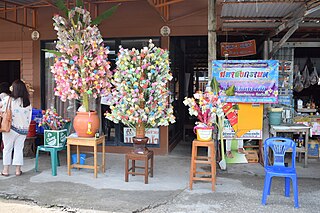
The banknotes of the Thai baht are part of the physical form of the Thai baht, Thailand's currency. The issuance of the baht banknotes is managed by the Bank of Thailand. Throughout its history, the denominations have ranged from 1 baht to 1,000 baht. The circulating banknotes today in Thailand, however, are ranged from 20 baht, 50 baht, 100 baht, 500 baht and 1000 baht. The currently circulating series are 17th, 16th and 15th series. Thai baht banknotes commonly include the portrait or the picture of the sculpture of its kings. The obverses have been designed with the current king's portrait. Whilst, in the reverses, mostly the picture of notable kings and kings with the title "the great". Some reverses feature the King Bhumibol's sayings.
The 100 baht note (100฿) is one of the most commonly used Thai baht banknotes and has been used since 1892. The 17th series notes are currently in circulation having been introduced in 2018. The 15th, 16th and 16th (special) series are also very common in circulation. The front side shows a portrait of Vajiralongkorn, the current head of the state or the king. The reverse depicts King Chulalongkorn and King Vajiravudh.
The 20 baht note (20฿) is currently the lowest-in-value baht banknote and has been used since 1892. The 17th series notes are currently in circulation having been introduced in 2018. The 15th, 16th and 16th (special) series are commonly used as well. The front side shows a portrait of Vajiralongkorn, the current head of the state or the king. The reverse depicts Kings Phra Buddha Yodfa Chulaloke and Phra Buddha Loetla Nabhalai.

Wat Yansangwararam Woramahawihan or Wat Yan is located in Huai Yai in the Chonburi province of Thailand. It is a large Buddhist temple complex with gardens and lakes and has been under the patronage of Bhumibol Adulyadej. Most of the buildings at Wat Yansangwararam were erected in honor of the Thai Royal Family. The temple is a replica of the Mahabodhi Temple in Bodh Gaya, Bihar, India.
